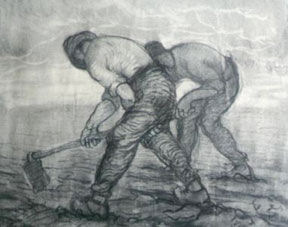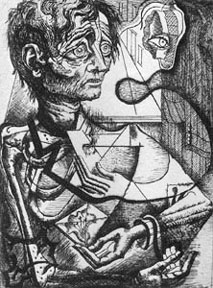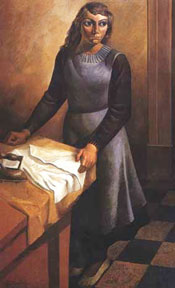
Artistas plásticos del sur
"VISUAL ARTISTS OF SOUTH AMERICA" ENGLISH VERSION
Lino Enea Spilimbergo
(1896-1964)
A pesar de tener una historia larga de pueblos indígenas y de conquistadores españoles, en realidad la Argentina es un país nuevo porque las inmigraciones europeas del fin del siglo XIX aumentaron la población enormemente e hicieron el país que conocemos hoy.
 Quizás se puede decir que Lino Enea Spilimbergo es el primer verdadero artista argentino no solo porque nació en Buenos Aires sino también porque hizo sus recorridos europeos cuando recién a sus 29 años. Por lo tanto era un artista ya conocido--no era un iniciado--cuando viajó a Europa. Sus experiencias allá reflejaron en sus obras la elección de estilos y épocas para estudiarlos mas que la irreflexiva absorción de la totalidad.
Quizás se puede decir que Lino Enea Spilimbergo es el primer verdadero artista argentino no solo porque nació en Buenos Aires sino también porque hizo sus recorridos europeos cuando recién a sus 29 años. Por lo tanto era un artista ya conocido--no era un iniciado--cuando viajó a Europa. Sus experiencias allá reflejaron en sus obras la elección de estilos y épocas para estudiarlos mas que la irreflexiva absorción de la totalidad.Spilimbergo Hombres trabajando, Dibujo de carbonilla, 1919
De esta manera, Spilimbergo aprendió algo de los geniales dibujantes del Renacimiento como Paolo Uccello y Andrea Mantegna, algo de los pintores franceses modernos como Paul Cézanne y Andre Lhote y algo del ambiente trastornado de Paris de los años 20--a veces clasicista, a veces cubista, a veces surrealista.

Al volver a Argentina en 1928, Spilimbergo usó estas novedades para enriquecer sus obras pero siempre guardó una honda preocupación por la humanidad, por su patetismo y por la fragilidad de la sobrevivencia individual.
Spilimbergo Interlunio 6, Grabado, 1937
Sus encuentros en Argentina en los 30 con el gran muralista mexicano Siqueiros reforzaron en la obra de Spilimbergo estos temas los cuales también impactaban a casi todos los artistas argentinos de la época. Desde entonces, para ser serio, el arte argentino necesitaría integrar en la obra elementos con contenido social.

Durante su vida y después, Spilimbergo ha sido admirado por sus contenporáneos argentinos como Antonio Berni y Raquel Forner y también por sus estudiantes como Eolo Pons y Carlos Alonso. Por consiguiente, la mentalidad spilimberguiana, con su técnica exigente de dibujos virtuosos y de composiciones arquitectónicas, todavía influyen la estética de los artistas argentinos.
Spilimbergo "La planchadora", Oleo, 1936
¿Por qué "Artistas plásticos del sur"?
Aunque Argentina y los Estados Unidos compartan raíces europeas, los artistas de cada país han elegido tomar caminos distintos. Los artistas argentinos mantuvieron una fuerte personalidad del país--pero no como artistas regionales sino como artistas con una conciencia mundial. Para un coleccionista norteamericano o europeo es como entrar en un universo paralelo--familiar, pero no parecido. Entonces, en estos artículos, Biddingtons trata de presentar algunos de los artistas argentinos, uruguayos y chilenos mas importantes del siglos XX y XXI.
Despite its long, rich history of indigenous peoples and Spanish conquerors, Argentina is, in many ways, a new country. The immigration of Europeans at the end of the 19th century vastly increased its population, and the influence of this flood of newcomers helped to transform Argentina into the country we know today.
Lino Enea Spilimbergo might be called the first truly Argentine artist. Born in Buenos Aires, Spilimbergo voyaged to Europe to study art when he was 29, an age when he was already well known and winning awards for his work in Argentina. During his European travels, Spilimbergo selected for himself which European artists, movements and periods to examine rather than to take it all in--as a less mature artist might have done.
In his own way, Spilimbergo borrowed from the first Renaissance geniuses such as Paolo Uccello and Andrea Mantegna, from the French modernists such as Paul Cezanne and Andre Lhote as well as from the lively creative environment that was Paris in the 1920's, at turns classicist, cubist or surrealist.
Upon returning to Argentina, Spilimbergo used these new tools to enrich his work. As before his travels, Spilimbergo's art continued to realize his deep concern for humankind, the pathos of living and the fragility of individual survival.
His contact in Argentina in the 1930's with the exiled Mexican muralist Siqueiros reinforced these themes in Spilimbergo's work. These same preoccupations also greatly impacted other Argentinean artists of the period. From this point onward, to be deemed "serious", an Argentine artwork would be expected to include social content.
During his lifetime, Spilimbergo was greatly admired by his contemporaries such as Antonio Berni and Raquel Forner, and he continues to be esteemed through the legacy of his important students such as Eolo Pons and Carlos Alonso. Spilimbergo's rigorous tenets requiring technical skill both in virtuoso drawing and in architectonically sound composition continue to exert a powerful influence on the aesthetic of 21st century Argentinean artists.
About Visual Artists of South America
Even though Argentina and the US share European roots, the artists in these countries have chosen to follow different aesthetic paths. In their artworks, Argentinean artists have maintained a strong national character, not merely as regional artists but instead as painters and sculptors with an international consciousness. For North American and European collectors and students, South American art represents a parallel universe--familiar, but not quite the same. This series of articles is designed to introduce some of the key 20th and 21st century visual artists from Argentina, Uruguay and Chile to a broader audience.
Archivo/Archive:
Xul Solar
Lino Enea Spilimbergo
COPYRIGHT: Information within www.biddingtons.com is Copyright Biddington's, Inc.--except where preceded by individual copyrights of the artists.
Downloading or printing for online or print reproduction of any materials without specific written permission from Biddington's, Inc. is prohibited.

 Quizás se puede decir que Lino Enea Spilimbergo es el primer verdadero artista argentino no solo porque nació en Buenos Aires sino también porque hizo sus recorridos europeos cuando recién a sus 29 años. Por lo tanto era un artista ya conocido--no era un iniciado--cuando viajó a Europa. Sus experiencias allá reflejaron en sus obras la elección de estilos y épocas para estudiarlos mas que la irreflexiva absorción de la totalidad.
Quizás se puede decir que Lino Enea Spilimbergo es el primer verdadero artista argentino no solo porque nació en Buenos Aires sino también porque hizo sus recorridos europeos cuando recién a sus 29 años. Por lo tanto era un artista ya conocido--no era un iniciado--cuando viajó a Europa. Sus experiencias allá reflejaron en sus obras la elección de estilos y épocas para estudiarlos mas que la irreflexiva absorción de la totalidad.
